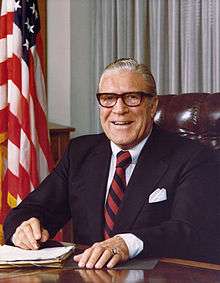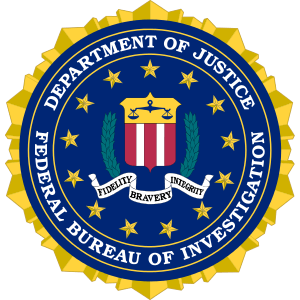Clarence M. Kelley
| Clarence M. Kelley | |
|---|---|
 | |
| 2nd Director of the Federal Bureau of Investigation | |
|
In office July 9, 1973 – February 15, 1978 | |
| President |
Richard Nixon Gerald Ford Jimmy Carter |
| Preceded by | William Ruckelshaus (Acting) |
| Succeeded by | James B. Adams (Acting) |
| Personal details | |
| Born |
October 24, 1911 Kansas City, Missouri, U.S. |
| Died |
August 5, 1997 (aged 85) Kansas City, Missouri, U.S. |
| Political party | Republican |
| Spouse(s) |
Ruby Pickett (1937–1975) Shirley Dyckes (1976–1997) |
| Children |
Kent Mary Ruth |
| Alma mater |
University of Kansas, Lawrence University of Missouri, Kansas City |
| Religion | Christianity |
Clarence M. Kelley (October 24, 1911 – August 5, 1997) was an American law enforcement officer who served as the second Director of the Federal Bureau of Investigation.
Early life and education
Clarence Kelley was born in Kansas City, Missouri in 1911. He received his Bachelor of Arts degree from the University of Kansas in 1936 as a member of Sigma Nu fraternity. He then continued his education to earn an LL.B. from the University of Kansas City, Missouri, in 1940. He was admitted to the Missouri Bar the same year and joined the Federal Bureau of Investigation as a Special Agent on October 7, 1940. He served in field offices in Huntington, West Virginia; Pittsburgh, Pennsylvania; Des Moines, Iowa; and the FBI Training Center in Quantico, Virginia.
Kelley served in the United States Navy from July 22, 1944, to April 9, 1946, having been granted military leave from the FBI.
Career
Returning from military service Kelley was assigned to the Kansas City office, where his performance earned him a promotion to field supervisor. He also served at FBI Headquarters in Washington, D.C. in 1951. From July 1953 to July 1957 he served as Assistant Special Agent in Charge at the Houston, Seattle, and San Francisco offices. He was then transferred to the Training and Inspection Division at FBI Headquarters, becoming an Inspector. In December 1957 he was promoted to Special Agent in Charge of the Birmingham office and was reassigned to the Memphis office in November 1960, where he served as Special Agent in Charge until his retirement from the FBI on October 24, 1961.
Later career
After retiring from the FBI Kelley became the Chief of Police in Kansas City, Missouri. During that time he was a member and officer of several civic associations. He is acknowledged and respected as an innovator who created the first helicopter division as well as installing the first computer systems in the Kansas City Police Department.[1]
Kelley founded Clarence M. Kelley and Associates, Inc (CMKA), a security and investigation firm, in 1982 after retiring from the FBI. CMKA is now one of the nation's leading Professional Investigative and Security Consulting Firms.
Awards and recognition
In 1970 Kelley received the J. Edgar Hoover Gold Medal for Outstanding Job Service, presented by the Veterans of Foreign Wars. The following year he was named to the Presidential Advisory Committee, and served on both the National Advisory Commission on Criminal Justice Standards and Goals and on the FBI National Academy Review Committee from 1972–1973.
On June 7, 1973, President Richard M. Nixon nominated Kelley to be Director of the FBI. The United States Senate confirmed the nomination June 27 and he was sworn in on July 9. Kelley was the first Director of the FBI to be appointed through the nomination and confirmation process.
Later life
During his time as Director, Kelley is known for eliminating the embezzlement practices that had been prevalent in the administrative division under J. Edgar Hoover's directorship through his cooperation with a Justice Department investigation.[2] Kelley also reopened relations with other intelligence agencies, such as the CIA which had nearly been shut down by Hoover in his last years as director.[3] Kelley helped the FBI transition from its 40 plus years of being dominated by a single director, J. Edgar Hoover, by improving the public image of the FBI as an organization in change albeit without making the change forceful enough to FBI agents who had been loyal to Hoover.[4]
Kelley announced his intention to retire in 1977, prompting an exhaustive year-long search for a successor. President Jimmy Carter finally decided on William H. Webster, who was nominated in January 1978.
Retirement
Kelley retired from the FBI February 15, 1978 and was temporarily succeeded by James B. Adams, who served as Acting Director until Webster's confirmation two weeks later.
Death
Kelley died on August 5, 1997 in his sleep from natural causes in his Kansas City home. His remains were later buried at Mount Washington Cemetery in Independence, Missouri. He was buried next to his wife who died in 1975 from cancer.
References
- ↑ "The Nation: Chief Clarence Kelley: A Dick Tracy for the FBI". Time. June 18, 1973. Retrieved 2010-04-05.
- ↑ Gentry, Curt (1992). J. Edgar Hoover: The Man and the Secrets. New York, NY: W.W. Norton & Company, Inc. ISBN 978-0-393-32128-9.
- ↑ Gentry, Curt (1992). J. Edgar Hoover: The Man and the Secrets. New York, NY: W.W. Norton & Company, Inc. ISBN 978-0-393-32128-9.
- ↑ Gentry, Curt (1992). J. Edgar Hoover: The Man and the Secrets. New York, NY: W.W. Norton & Company, Inc. ISBN 978-0-393-32128-9.
Further reading
- Kelley, Clarence M.; James Kirkpatrick Davis (1987). Kelley: The Story of an FBI Director. Kansas City: Andrews, McMeel & Parker. ISBN 0-8362-7935-2. Kelley's memoirs.
- Gentry, Curt (1992). J. Edgar Hoover: The Man and the Secrets. New York, NY: W.W. Norton & Company, Inc. ISBN 978-0-393-32128-9.
External links
| Government offices | ||
|---|---|---|
| Preceded by William Ruckelshaus Acting |
Director of the Federal Bureau of Investigation 1973–1978 |
Succeeded by James B. Adams Acting |
